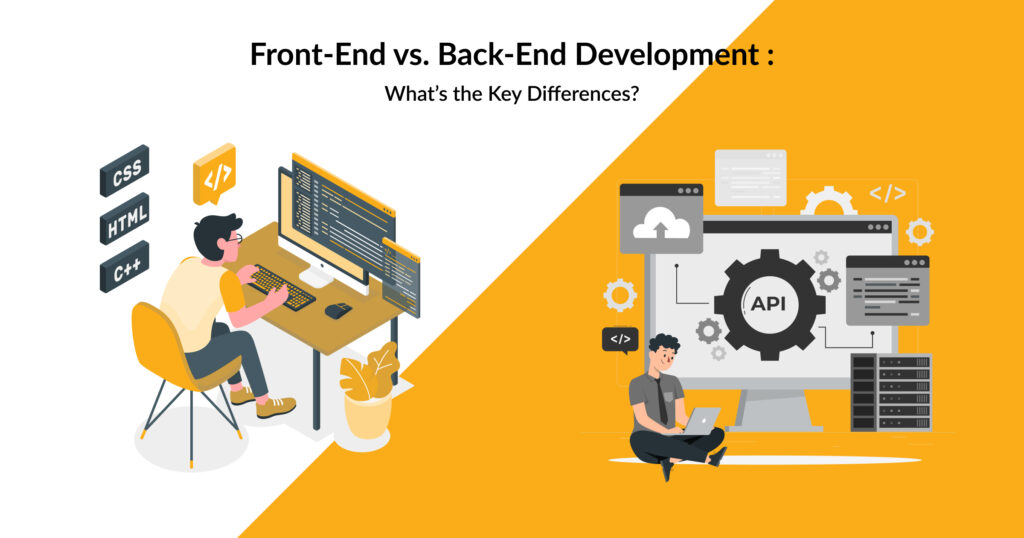The Difference Between Front-End vs. Back-End
Table of Contents
The Difference Between Front-End vs. Back-End Development: A Simple Guide for Businesses
Your website is more than just a digital business card. It’s an essential tool for your customers to learn about your services, browse products, and even make purchases. But how your website looks and functions involves two main areas of development: front-end (what users see) and back-end (how things work behind the scenes).

Introduction
Your website is more than just a digital business card. It’s an essential tool for your customers to learn about your services, browse products, and even make purchases. But how your website looks and functions involves two main areas of development: front-end (what users see) and back-end (how things work behind the scenes).
Let’s break down these two terms and understand why each plays a vital role in your business’s online success.
What is Front-End Development?
Front-end development refers to the part of a website or application that users interact with directly. When you land on a webpage, everything you see — the text, images, buttons, and layout — is created by a front-end developer. They focus on making the site look attractive and ensuring it’s easy to navigate.
Key Responsibilities of a Front-End Developer:
- Design Implementation: They turn a web designer’s mockups into actual code that runs on a browser.
- Responsive Design: Front-end developers ensure that websites look good on all devices, including phones, tablets, and desktop computers.
- User Experience (UX): Front-end developers focus on how users interact with the site, ensuring smooth navigation, fast load times, and accessibility.
- Optimization: Front-end development also includes optimizing images and files to ensure faster site performance.
Common Front-End Technologies:
- HTML (HyperText Markup Language): Structures the website content.
- CSS (Cascading Style Sheets): Styles and formats the content to look attractive.
- JavaScript: Adds interactivity to elements, such as buttons or sliders.
Why Does Front-End Matter to Your Business?
Your website’s front-end is the first thing users see. A well-designed interface can help improve customer satisfaction, lead to more sales, and build your brand. Poor front-end design, however, can drive visitors away due to slow load times, confusing navigation, or unattractive layouts.
What is Back-End Development?
Back-end development refers to the server side of a website, where all the magic happens behind the scenes. It’s what powers the front-end. Without back-end development, the website wouldn’t be able to function properly. This includes storing and retrieving data, managing users, and even processing orders.
Key Responsibilities of a Back-End Developer:
- Server Management: Ensures the server is running efficiently and securely.
- Database Integration: Manages data and ensures that it can be stored, retrieved, and updated smoothly.
- APIs (Application Programming Interfaces): Creates pathways for communication between different parts of a web app or external services.
- Security: Focuses on keeping user data secure from potential breaches.
Common Back-End Technologies:
- Node.js: A popular back-end framework for running JavaScript on the server.
- Python: Known for being user-friendly and often used in data-heavy applications.
- Ruby on Rails: A full-stack framework that simplifies common tasks in web development.
- SQL Databases: Store data in a structured way for easy retrieval.
Why Does Back-End Matter to Your Business?
If your front-end is the face of your business, the back-end is the backbone. The back-end ensures your website or app functions smoothly, especially for features like user accounts, online transactions, and data management. It’s crucial for providing a seamless experience for your users.
The Key Differences Between Front-End and Back-End
To make it easier, here’s a simple comparison:
| Aspect | Front-End Development | Back-End Development |
|---|---|---|
| Focus | Looks and feels of a website | Logic, database, and server management |
| Main Languages | HTML, CSS, JavaScript | Python, Ruby, Node.js, SQL |
| User Interaction | Directly interacts with users | Works behind the scenes |
| Responsibility | User experience, visual design | Data processing, server management |
| Common Tools | Frameworks like React, Vue, and Angular | Frameworks like Django, Flask, and Ruby on Rails |
Choosing the Right Developer for Your Business
As a business owner, understanding the difference between front-end and back-end development is essential when hiring a developer or team. You need to know which area your project requires or if you need full-stack development, which covers both areas.
When to Hire a Front-End Developer:
- You need a visually appealing website or app.
- Your focus is on improving user experience and design.
- You want to ensure your site works well on all devices.
When to Hire a Back-End Developer:
- You need a data-heavy application.
- Your website requires user accounts, databases, or e-commerce functionality.
- Security and server management are top priorities.
If your business needs a combination of both, you may want to hire a full-stack developer who can handle both front-end and back-end tasks. This can streamline communication and ensure consistency across your project.
Challenges in Front-End and Back-End Development
Despite their importance, both front-end and back-end development come with their own set of challenges:
-
Front-End Challenges:
- Ensuring cross-browser compatibility
- Handling performance optimization
- Managing responsive designs for various devices
-
Back-End Challenges:
- Scaling the server to handle increased traffic
- Securing data and protecting user privacy
- Ensuring smooth data flow between the front-end and back-end
At Upforce Tech, our team is well-versed in overcoming these challenges, providing reliable solutions for your business.
Why You Should Care About Front-End vs. Back-End
While it might seem tempting to focus only on one aspect, both front-end and back-end development are crucial for the success of your business. Imagine having a beautifully designed website (great front-end) but with slow load times or broken functionality (poor back-end). On the other hand, a well-functioning website (good back-end) with a cluttered or confusing interface (bad front-end) will also fail to keep users engaged.
Investing in both front-end and back-end development ensures that your website or app not only looks good but also functions properly, leading to a better user experience and, ultimately, more conversions.
How to Hire the Right Developer for Your Needs
Whether you’re looking for a front-end or back-end developer, or someone who can do both, finding the right talent is crucial. Here’s what you need to look for when hiring:
- Experience: Look for developers with a proven track record in building similar projects.
- Portfolio: Review their previous work to ensure it aligns with your business goals.
- Communication: Clear communication is key, especially if your team will include both front-end and back-end developers.
- Problem-Solving Skills: Developers need to be able to troubleshoot and solve technical issues quickly and efficiently.
At Upforce Tech, we specialize in providing skilled developers who understand your business needs. Whether you need front-end, back-end, or full-stack development, we have experts ready to help.
Conclusion
In summary, front-end development focuses on the design and user experience of a website or app, while back-end development powers everything behind the scenes. Both are essential for creating a well-rounded, functional, and user-friendly digital platform.
Want to ensure your website looks great and works even better? At Upforce Tech, we can help you find the perfect developer for your project. Visit us to learn more about our services and how we can help your business grow.
How UpforceTech Can Help You Hire the Right Contract Developer
At UpforceTech, we specialize in connecting businesses with highly skilled contract developers who can meet their unique needs. Our rigorous vetting process ensures that you get access to the best talent, whether you need someone with expertise in front-end development, back-end systems, or mobile app development.
Here’s how UpforceTech can support your business:
- Access to a Global Talent Pool: We provide access to a diverse range of developers from around the world, ensuring you find the right fit for your specific project needs.
- Customized Hiring Solutions: Whether you’re looking for short-term contract developers or long-term project-based teams, we tailor our services to fit your requirements.
- Quality Assurance: Every developer in our network goes through a comprehensive screening process to ensure they have the necessary skills and experience to deliver high-quality work.
- Ongoing Support: Our commitment doesn’t end with hiring. We offer ongoing support to ensure a seamless integration of contract developers into your team.
For more information on how to get started with hiring contract developers, visit UpforceTech.
Looking to boost your business with skilled developers? Hire a contract developer today to bring fresh ideas and expertise to your team. Learn how UpforceTech can help!
Sign up for the free Newsletter
A great user experience comes from a seamless collaboration between design and technology.
UpforceTech
FAQs
Front-end development focuses on the design, layout, and user experience of a website or app — everything the user interacts with. Back-end development deals with the server, database, and application logic that work behind the scenes to ensure the front-end functions smoothly.
It depends on your project. If your website or app involves complex user interactions, databases, and server management, you'll need both. For simpler projects, a front-end developer or full-stack developer might be enough.
Some of the most popular front-end frameworks are React.js, Vue.js, and Angular. These frameworks help developers build interactive, responsive user interfaces more efficiently.
Common back-end programming languages include Python, Ruby, Java, PHP, and Node.js. These languages help developers build the logic and systems that run behind the scenes.
Yes, hiring two specialists might increase costs compared to hiring a single full-stack developer. However, having both ensures that each area of your website or app is handled by an expert, which can result in a higher-quality product.
Consider your project’s needs. If it requires a lot of user interaction and design, prioritize a front-end developer. For data-heavy or complex functionality, you'll need a back-end developer. For projects that require both, a full-stack developer may be the best choice.
Responsive design ensures that your website or app looks good and works well on all devices, from mobile phones to desktops. This is crucial for providing a good user experience, no matter what device your customers use.
Back-end developers focus heavily on security to protect user data, especially in websites that handle sensitive information like credit card numbers or personal details. They implement security protocols to prevent data breaches and cyber-attacks.


One Response